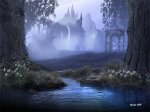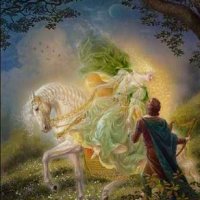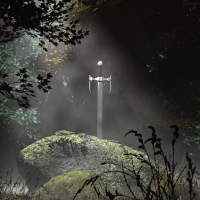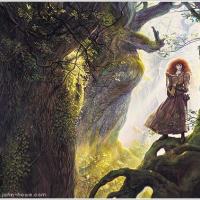One of the most stirring aspects of the Arthurian legends are the wondrous lands which those myths tell of. Places like Camelot, Lyonesse and Avalon are inhabited by a mesmerising cast of knights, fair ladies, wizards and mythic beasts of all kinds. Camelot, Arthur’s shining city-castle, drew knights from far and wide to join the Fellowship of the Round Table, inspired by ideals of courage, honour and chivalry. Avalon was another name for the Otherworld, and was the place where Arthur’s sword Excalibur was forged, as well as being the supposed site of his eventual tomb. Lyonnesse, meanwhile, was a land of strange beauty and romance, site of the tangled love story of Tristan and Iseult. What many people do not realise, however, is that all of these places have definite historical and modern counterparts in the real-life British Isles. One only needs to look to England’s mythical west country to find the likes of Camelot, Lyonnesse and Avalon, while even more obscure places, such as the Grail Castle of Carbonek, Arthur’s birthplace at Tintagel and the grim fortress of Perilous Garde can all also be found. If you look hard enough, the lost realms of King Arthur are not all quite as far away as you might think.
In Arthurian legend, Camelot was the seat of King Arthur’s court – the ‘many towered’ castle of Alfred, Lord Tennyson’s immortal poem The Lady of Shalott. It is variously identified with Caerleon in Monmouthshire, Wales; with Queen Camel in Somerset; with the little town of Camelford in Cornwall; with Winchester in Hampshire and with Cadbury Castle in Somerset. All of these places have sound claims. Winchester is the location of the infamous ‘fake’ round table created by a Plantagenet monarch to legitimise his claim to the throne. Queen Camel is the site of Camlann, Arthur’s last battle, in which the king receives a mortal wound from Sir Mordred. Dozmary Pool, a lonely moorland lake a few miles from Camelford, is said to be the lake in which Sir Bedivere, the last of Arthur’s knights, flung his sword Excalibur. Cadbury Castle is a neolithic fort that stands in sight of Glastonbury Tor. Modern excavations at this hill-top earthworks proved recently that this was once the military headquarters of a 6th century chieftain who was at least as powerful as King Arthur. Certainly this is a place, and a part of the country, replete with Arthurian associations. The tradition held widely at Cadbury Hill, for example, was that Arthur and his heroic host rode there on nights when the autumn moon was full and bright.
Avalon, the island to which Arthur was conveyed for the healing of his wounds after his final battle, has been identified as Glastonbury, a market town in Somerset. Once Glastonbury and its conical hill, Glastonbury Tor, rising from a vast inland lake that covered much of present day Somerset, had been a sacred site of the Old Religion of the British Isles. Even today, it is a place where the very air is alive with the stuff of myth and legend. In Arthurian legend it was ruled by the enchantress Morgan le Fay and her eight sisters, every one of them skilled in the magical arts. Before that, it was said to be ruled by the dark Celtic deity Aballach. It has variously been called the ‘Isle of apples’ and the ‘Isle of glass’. In the Christian era, it was said to be the place where Joseph of Arimathea came carrying the Holy Grail in order to found Britain’s first church. When Joseph buried the Grail containing Christ’s blood at the foot of the Tor, a spring gushed open, spreading miraculous healing water and became Chalice Well. Joseph’s staff, meanwhile, took root when he planted it on Wearyall Hill just west of the town and grew into the Holy Thorn that blossoms there each Christmas.
Lyonnesse was the mythical lost land supposed once to have connected Cornwall in the west of England with the Scilly Isles lying in the English Channel. In Arthurian legend it was also the native land of the hero Tristan and his doomed love affair with Iseult. Quite separate from Arthurian legend, however, was a tradition (known at least since the 13th century) that concerned a submerged forest in this region that once extended all the way from St Michael’s Mount to the Scilly Isles. This was a place of fine cities and 140 churches, so the local story goes, until the great storm of 1099, when the sea swept over it and left the church bells ringing below the waves. Today this region encompasses everything from genteel, cosy villages to vast, Atlantic-facing strands of golden sand and wild expanses of granite moorland. The country beckons ever westwards into rural backwaters where increasingly exotic place names and idiosyncratic pronunciations recall that this was once England’s last bastion of Celtic culture, a site steeped in Arthurian legend to this day.
See also:


















Most enjoyable! 🙂 Big smiles here.
Another outstanding post! Great work, very enjoyable and informative as always! 😀
I love Arthurianna, both the historical and mythical setting, and the stories.
Some years ago, I spent a week in Cornwall and saw most of the Cornish sites you mentioned. It is a wonderful, out of the way corner of England, very different from the bustle of London. We staying at a small fishing village at a friend’s cottage that was called “The New Cottage”, since it was the youngest in the village, having been built about 1600.
You can get a sense of the countryside in the 5th and 6th century if you have good imagination but, of course, almost everything but the rocks is much more recent, including Tintagel. It was actually active in the 5th century but what you see dates from much later and isn’t all that much to look at. Still, it is a spectacular headland and you can certainly get a sense for why someone choose the site for a protected settlement of some sort.
Dozmary Pool was rather disappointing. It looks like any farmer’s pond, though a tad larger than most. There are some pretty hills in the vicinity but the barbed wire fence bisecting one corner of it kind of ruined the mood for me, as did the pasture land all around. And though purported to be bottomless, it has been known to dry up from time to time 🙂
Part of the fun of the stories is that they do not form a consistent myth. It is pretty clear that older, local myths were accreted to the story, thus the wide-spread Arthurian locales, and the various tales, many of which are pre-Christian in origin. There’s even much discussion of what, exactly, is a holy grail, with some scholars thinking it ties back to a pagan cornucopia.
Thanks for the post!
Great post! 😀
St Michael’s Mount would indeed have been surrounded by forest until relatively recent times, but not stretching all the way to the Scillies! Legend exaggerates. Similarly, there is no doubt the Scillies were once one big island most of which was drowned by rising sea levels, losing the best farming land, so this will have stuck in memories as a disaster, albeit a fairly slow one. I don’t think the Scillies were ever connected to the mainland, but that’s mythological license again. Tintagel does seem to have been an important place in the Dark Ages, with, I believe, evidence of trading visits by Byzantine merchants.
This information adds another dimension to my travels around England. Thank you.
I’ve never left North America in my life, but someday I’d like to see some of these mythological sites. As far as Avalon goes, I’ve read that some kings used the discovery of a corpse at Glastonbury sometimes said to be that of Arthur to debunk the idea that he’s coming back someday. The idea of a mythical island where apples grow reminds me of the Greek island of the Hesperides. I wrote a little bit about that here.
Hi! Are you the artist of the Avalon image? If not, do you know who the artist is? I want to use this image in a video and need to discuss how to go about this.